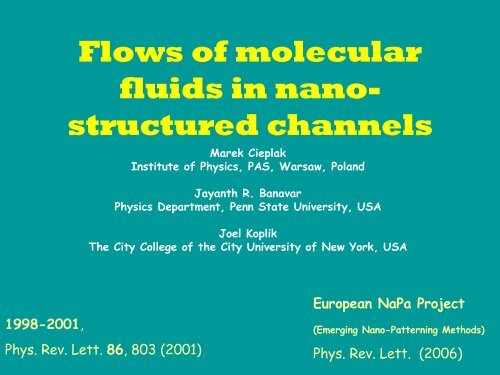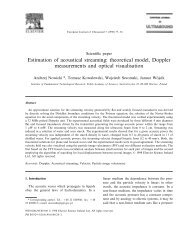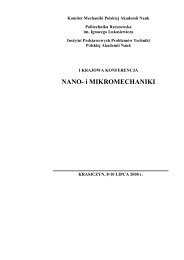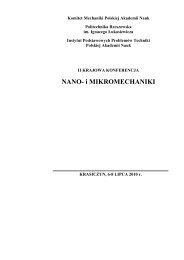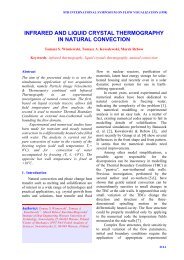Flows of molecular fluids in nano- structured channels
Flows of molecular fluids in nano- structured channels
Flows of molecular fluids in nano- structured channels
You also want an ePaper? Increase the reach of your titles
YUMPU automatically turns print PDFs into web optimized ePapers that Google loves.
<strong>Flows</strong> <strong>of</strong> <strong>molecular</strong><br />
<strong>fluids</strong> <strong>in</strong> <strong>nano</strong><strong>structured</strong><br />
<strong>channels</strong><br />
Marek Cieplak<br />
Institute <strong>of</strong> Physics, PAS, Warsaw, Poland<br />
Jayanth R. Banavar<br />
Physics Department, Penn State University, USA<br />
Joel Koplik<br />
The City College <strong>of</strong> the City University <strong>of</strong> New York, USA<br />
1998-2001,<br />
Phys. Rev. Lett. 86, 803 (2001)<br />
European NaPa Project<br />
(Emerg<strong>in</strong>g Nano-Pattern<strong>in</strong>g Methods)<br />
Phys. Rev. Lett. (2006)
Great<br />
Stour<br />
Da V<strong>in</strong>ci<br />
No-slip<br />
boundary<br />
conditions<br />
Jager, rectangular<br />
channel, f<strong>in</strong>ite<br />
difference method<br />
Poiseuille (1799-1869) –<br />
measured circulation <strong>in</strong> arteries<br />
Flow rate; the velocity pr<strong>of</strong>ile - parabolic
Situations that require<br />
<strong>molecular</strong>-level description<br />
Molecular Dynamics:<br />
Mov<strong>in</strong>g contact l<strong>in</strong>es<br />
Interfacial<br />
<strong>in</strong>stabilities<br />
(coalescence <strong>of</strong><br />
drops, rupture <strong>of</strong><br />
liquid threads,<br />
splashes)<br />
Non-Newtonian<br />
<strong>fluids</strong> (conformation<br />
affects the flow)<br />
Hasha & Bush MIT 2004 collision <strong>of</strong> lam<strong>in</strong>ar<br />
glycerol-water jets: fluid cha<strong>in</strong>s and fishbones<br />
With a cont<strong>in</strong>uum theory<br />
Slid<strong>in</strong>g friction <strong>of</strong><br />
atomic monolayers
Nature <strong>of</strong> the<br />
boundary<br />
conditions requires<br />
atomic-level<br />
understand<strong>in</strong>g<br />
velocity at the wall<br />
Millikan 1923:<br />
f=1 for air on mercury,<br />
mach<strong>in</strong>ed brass, old<br />
shellac<br />
f=0.89 for air on glass
How does the slip length<br />
depend on density<br />
Maxwell’s hypothesis (1879)<br />
Is it valid<br />
Important for m<strong>in</strong>iature<br />
systems <strong>in</strong> which surface<br />
related phenomena<br />
dom<strong>in</strong>ate the physics<br />
Kn=λ/L<br />
Huge slip length
New frontier: micr<strong>of</strong>luidics and nan<strong>of</strong>luidics<br />
Started with <strong>in</strong>kjet<br />
pr<strong>in</strong>ters. Control t<strong>in</strong>y<br />
amounts <strong>of</strong> <strong>fluids</strong><br />
C. Williams, Physics World 2006<br />
Kelv<strong>in</strong>’s patent 1867<br />
1994: Epson, Canon, HP<br />
50 μm <strong>in</strong> diameter<br />
accuracy 20 μm<br />
volume 3 x10 -12 l
micr<strong>of</strong>luidics and nan<strong>of</strong>luidics<br />
“lab on a chip”<br />
microreactor<br />
10 μm<br />
capillary<br />
electrophoresis<br />
Matzke<br />
Troian – T gradients<br />
micromixer<br />
<strong>in</strong> glass<br />
Breuer (Brown): ‘bacteria carpet’<br />
Harness<strong>in</strong>g Serratia mercescens to push particles<br />
through rubber <strong>channels</strong> with 12 μm long flagellae<br />
(at 25 μm/s; controlled by glucose)
Controlled microlenses<br />
Yang (UPenn) &<br />
Aizenberg (Lucent)<br />
Carbon microbatteries<br />
Madou (UC Irv<strong>in</strong>e)<br />
C-MEMS with LiMn 2<br />
O 4<br />
3 V micro-power
E-NOSE<br />
Detection and monitor<strong>in</strong>g <strong>of</strong> gases and vapors<br />
Conductive polymers (polyanil<strong>in</strong>e, polypyrrole,<br />
filled <strong>nano</strong>-tube) change work function on<br />
adsorption.<br />
C3B @ Clemson<br />
Tra<strong>in</strong> for odors
Lennard-Jones <strong>fluids</strong><br />
ARGON:<br />
ε/k B<br />
=120 K<br />
σ = 3.405 A τ = 10 fs<br />
r c<br />
– cut<strong>of</strong>f <strong>in</strong> the potential<br />
r c<br />
=2.2σ
Interactions with<br />
the wall atoms<br />
controlled by A<br />
-<br />
-<br />
The channel geometry<br />
A=1 strongly attractive<br />
or strongly wett<strong>in</strong>g<br />
A=0 purely repulsive or<br />
non-wett<strong>in</strong>g<br />
Knudsen<br />
regime<br />
Discuss first<br />
homogeneous, then<br />
patterned walls
The density pr<strong>of</strong>ile for A=1<br />
Ballistic motion between the walls at low density
Atoms sent normally<br />
towards to wall with a<br />
unit velocity –<br />
distribution <strong>of</strong> velocities<br />
<strong>of</strong> the reemerg<strong>in</strong>g atoms<br />
Maxwell’s hypothesis<br />
valid at A=1 and A=0<br />
but not <strong>in</strong>-between<br />
ζ needs to be<br />
determ<strong>in</strong>ed at the<br />
<strong>molecular</strong> level
Monatomic<br />
fluid<br />
Thermal<br />
slip also<br />
studied
Double the<br />
width <strong>of</strong><br />
the channel<br />
v x<br />
(z)=<br />
ρg/2η (L/2+z)(L/2-z)<br />
ballistic
The build-up <strong>in</strong><br />
the second layer<br />
makes the<br />
effective flowwidth<br />
narrower<br />
A rigid near-wall<br />
structure <strong>in</strong> the<br />
polymeric case
The slip length for various values <strong>of</strong> A<br />
An accelerat<strong>in</strong>g flow for A=0<br />
ouette and Poisseuille results comb<strong>in</strong>ed
Poisseuille flows <strong>in</strong> mixed wettability <strong>channels</strong><br />
Polymeric n=10<br />
(the length doubled)<br />
N=1200 N=240<br />
Pr<strong>of</strong>iles at<br />
A=1 A=0 wett<strong>in</strong>g non-wett<strong>in</strong>g<br />
A B C<br />
(glass)
Variations <strong>in</strong> the velocity pr<strong>of</strong>ile along the channel<br />
A: wett<strong>in</strong>g<br />
B: at the switch<br />
C: non-wett<strong>in</strong>g<br />
Stationary<br />
plug flow at c
Chemical pattern<strong>in</strong>g yields novel stationary<br />
flows that are spatially <strong>structured</strong><br />
red – fast<br />
turquoise - slow<br />
Dense- mov<strong>in</strong>g to an<br />
effectively wider channel<br />
Rarefied – mov<strong>in</strong>g to a<br />
substantially lower<br />
density (no dissipation at<br />
non-wett<strong>in</strong>g walls)
A non-wett<strong>in</strong>g<br />
droplet at T/ε=0.8<br />
180 polymeric<br />
molecules <strong>of</strong> n=10<br />
Green- A 2<br />
:<br />
less attractive<br />
Chemical<br />
pattern<strong>in</strong>g:<br />
patches
x-displacement <strong>of</strong> the center <strong>of</strong> mass<br />
The droplet moves faster on the<br />
patterned surface – the lotus effect<br />
Selected 2<br />
particles - roll<strong>in</strong>g
Barthlott & Nienhuis 1997: ‘Purity <strong>of</strong> the sacred lotus, or<br />
escape from contam<strong>in</strong>ation <strong>in</strong> biological surfaces’<br />
Querre 2002<br />
Super-hydrophobic<br />
Contact angles > 90 o<br />
The surface <strong>of</strong> a lotus<br />
leaf is always clean<br />
Droplets collect<br />
hydrophilic dirt<br />
<strong>nano</strong>- and micro structures<br />
SEM image
A droplet on a<br />
hydrophilic rough<br />
surface (Θ < 90 o )<br />
s<strong>in</strong>ks <strong>in</strong>to the gaps<br />
On a rough<br />
hydrophobic<br />
surface - sits<br />
on the spikes<br />
Droplets do not slide<br />
down but roll <strong>of</strong>f and<br />
capture impurities
Gecko hair (setae) is t<strong>in</strong>y and facilitates<br />
formation <strong>of</strong> van der Waals bonds both<br />
with hydrophobic and hydrophylic surfaces<br />
The role <strong>of</strong> water-based forces: disputed<br />
Hang <strong>of</strong>f any surfaces<br />
at any angle<br />
Synthetic gecko tape. Flexible plastic hairs 2 μ high
Electrowett<strong>in</strong>g – control <strong>of</strong> surface<br />
tension through electric field<br />
Fair & Pollack (Duke); KCl droplet<br />
0.15mm diameter 1.5 m/s
GEOMETRICAL PATTERNING<br />
very different – as though<br />
there were no wall corrugation<br />
Knudsen<br />
Dense fluid
Droplet on pillars – geometrical pattern<strong>in</strong>g<br />
Very sensitive to the value <strong>of</strong> A – variations by 1/16<br />
Marg<strong>in</strong>ality moved to a lower value <strong>of</strong> A compared to chemical pattern<strong>in</strong>g
Faster motion at the<br />
marg<strong>in</strong>al value <strong>of</strong> A<br />
Detachment<br />
if no steps
Choi & Kim UCLA 2006<br />
Slip length <strong>of</strong> order<br />
20 μm for water on<br />
teflon-coated<br />
silicon “<strong>nano</strong>turf”<br />
Smooth surface –<br />
contact angle 120 o<br />
On <strong>nano</strong>turf: 175 o<br />
(hydrophilic: use O 2<br />
plasma)
Evaporation <strong>of</strong> a droplet on a temperature controlled surface<br />
ZX<br />
XY
Two k<strong>in</strong>ds <strong>of</strong> miscible cha<strong>in</strong>s –<br />
the red molecules stick to the<br />
surface once near it<br />
S<strong>of</strong>t lithography<br />
The result<strong>in</strong>g<br />
pattern on the<br />
surface
A mov<strong>in</strong>g droplet – <strong>molecular</strong> comb<strong>in</strong>g<br />
XZ<br />
XY
EVAPORATION ON A<br />
PATTERNED SURFACE
CONCLUSIONS<br />
Molecular dynamics studies elucidate the nature <strong>of</strong> the boundary<br />
conditions and the slip length at solid-fluid <strong>in</strong>terfaces.<br />
Maxwell’s scenarios <strong>of</strong> behavior near the wall realized only <strong>in</strong><br />
the limit<strong>in</strong>g cases – crossover complicated<br />
The slip length (also <strong>in</strong> thermal slip) is a sensitive function <strong>of</strong><br />
the wall-fluid <strong>in</strong>teractions and <strong>of</strong> the density<br />
Reconstruction <strong>in</strong> the density pr<strong>of</strong>ile near the wall leads to<br />
a maximum <strong>in</strong> the flow velocity as a function <strong>of</strong> density<br />
Mixed wetability <strong>channels</strong> generate stationary plug flows <strong>in</strong> the<br />
non-wett<strong>in</strong>g regions. Different crossovers from wett<strong>in</strong>g to<br />
non-wett<strong>in</strong>g regions for the dense and Knudsen cases.<br />
Hydrophobic patterned surfaces give rise to the lotus-like behavior
21 μm x 100 μm K. Breuer 2003<br />
Stationary meniscus<br />
AIR<br />
WATER<br />
The two –<br />
fluid case<br />
Hydrophilic<br />
(glass)<br />
Hydrophobic<br />
(glass coated by OTS)
Molecular Dynamics: fixed volume V and fixed energy – the simplest case<br />
N particles, mass m: N vectorial Newton<br />
equations. For the x-component <strong>of</strong> the i’th<br />
particle: F ix<br />
= ma ix<br />
F ix<br />
U r , r ,..., r )<br />
x<br />
(<br />
1 2 N<br />
Start from an <strong>in</strong>itial state, e.g. atoms on a lattice.<br />
Time averages <strong>of</strong> quantities after transient effects die out<br />
Simple difference formulae Verlet, Phys. Rev. 159, 98 (1967)<br />
Runge-Kutta methods Berne et al. Adv. Chem. Phys. 17, 63 (1970)<br />
Williamson, J. Comput. Phys. 35, 48 (1980)<br />
Predictor-corrector schemes Rahman, Phys. Rev. A 136, 405 (1964)<br />
Fifth-order predictor-corrector method due to C. W. Gear<br />
Numerical Initial Value Problems <strong>in</strong> Ord<strong>in</strong>ary<br />
Differential Equations, Prentice-Hall, 1971
PREDICTOR-CORRECTOR<br />
Prediction: <strong>molecular</strong> positions r i<br />
and their first five time-derivatives at<br />
time (t+Δt) are predicted by Taylor’s expansion from their values at time t<br />
Evaluation: force on each molecule F i<br />
at time (t+Δt) is calculated us<strong>in</strong>g the<br />
predicted positions<br />
Correction: an error term <strong>in</strong> the acceleration Δa i<br />
is obta<strong>in</strong>ed from the<br />
difference between the predicted acceleration and that given by the<br />
force F i<br />
. This error is used to correct the predicted positions and their<br />
time-derivatives<br />
Characteristic time<br />
τ=σ√m/ε<br />
ARGON: τ = 10 fs<br />
Divide <strong>in</strong>to small time <strong>in</strong>tervals Δt = τ/200<br />
A box with the periodic boundary conditions - if possible
X = x i<br />
Xm = x (m) i (Δt)m /m! The m’th derivative m=0,1,2,3,4,5<br />
X P (t+Δt)=X(t)+X1(t)+X2(t)+X3(t)+X4(t)+X5(t)<br />
X1 P (t+Δt)=X1(t)+2X2(t)+3X3(t)+4X4(t)+5X5(t)<br />
X2 P (t+Δt)=X2(t)+3X3(t)+6X4(t)+10X5(t)<br />
X3 P (t+Δt)=X3(t)+4X4(t)+10X5(t)<br />
X4 P (t+Δt)=X4(t)+5X5(t)<br />
X5 P (t+Δt)=X5(t)<br />
Error: ΔX2=X2(t+Δt)-X2(t+Δt)<br />
X(t+Δt)= X P (t+Δt) + α 0<br />
ΔX2<br />
X1(t+Δt)=X1 P (t+Δt) + α 1<br />
ΔX2<br />
X2(t+Δt)=X2 P (t+Δt) + α 2<br />
ΔX2<br />
X3(t+Δt)=X3 P (t+Δt) + α 3<br />
ΔX2<br />
X4(t+Δt)=X4 P (t+Δt) + α 4<br />
ΔX2<br />
X5(t+Δt)=X5 P (t+Δt) + α 5<br />
ΔX2<br />
α m<br />
depend on the degree <strong>of</strong> the differential<br />
equations and on the order <strong>of</strong> the Taylor<br />
series used: to ensure numerical stability<br />
5’th order:<br />
3/16, 251/360, 1, 11/18, 1/6, 1/60<br />
3’rd order:<br />
1/6, 5/6, 1, 1/3
Calculation <strong>of</strong> the forces: the most time-consum<strong>in</strong>g part <strong>of</strong> an MD simulation<br />
N(N-1)/2 pairs <strong>of</strong> atoms<br />
Cut<strong>of</strong>f r c<br />
: r ij<br />
> r c<br />
then F=0<br />
r c<br />
= 2.5σ or 2.2σ<br />
Verlet list: for each particle keep a list <strong>of</strong> neighbor<strong>in</strong>g atoms<br />
that lie with<strong>in</strong> a distance r L<br />
<strong>of</strong> i, where r L<br />
> r c<br />
(slightly)<br />
Update the list periodically, say, every 10 steps.<br />
r L<br />
=r c<br />
+ 0.3σ - typically 40 neighbors<br />
Study diffusion <strong>of</strong> one atom to<br />
dist<strong>in</strong>guish between liquid and solid<br />
Temperature, energy, correlations,<br />
pressure form the virial theorem
Velocity pr<strong>of</strong>iles change<br />
little along the channel<br />
Density pr<strong>of</strong>iles do change:<br />
coat<strong>in</strong>g <strong>of</strong> the walls
A non-wett<strong>in</strong>g fluid droplet mov<strong>in</strong>g along a <strong>nano</strong>comb<br />
A horizontal<br />
pressure gradient<br />
Acceleration <strong>of</strong> the center <strong>of</strong> mass goes<br />
down on mak<strong>in</strong>g the ‘canyons’ deeper<br />
movement<br />
A=3/16<br />
T=0.8<br />
1800 fluid molecules;<br />
atomic wall (vibrat<strong>in</strong>g)
A=1/4<br />
sticks<br />
Location <strong>of</strong> the center <strong>of</strong> mass as a<br />
function <strong>of</strong> time – parabolic except for A=1<br />
Strongly non-wett<strong>in</strong>g: corrugation<br />
does not affect the motion<br />
A=<br />
flat<br />
moves<br />
Solid l<strong>in</strong>e: the corrugated wall<br />
Dotted l<strong>in</strong>e – flat wall
Other studies:<br />
Work on evaporation <strong>of</strong> b<strong>in</strong>ary droplets – self<br />
organization <strong>of</strong> particles that attach to the surface<br />
– with Toulouse<br />
Preparatory work on particles fall<strong>in</strong>g on a comb-like<br />
surface (Toulouse): where do they deposit<br />
Hydrodynamic and entropic effects
THERMAL SLIP
Droplet<br />
coalescence<br />
MD appropriate<br />
when <strong>molecular</strong><br />
effects are<br />
important


